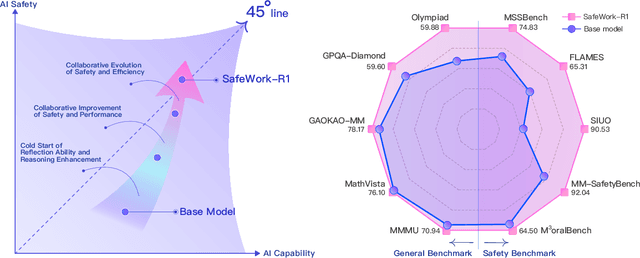Ziqi Miao
SafeWork-R1: Coevolving Safety and Intelligence under the AI-45$^{\circ}$ Law
Jul 24, 2025



Abstract:We introduce SafeWork-R1, a cutting-edge multimodal reasoning model that demonstrates the coevolution of capabilities and safety. It is developed by our proposed SafeLadder framework, which incorporates large-scale, progressive, safety-oriented reinforcement learning post-training, supported by a suite of multi-principled verifiers. Unlike previous alignment methods such as RLHF that simply learn human preferences, SafeLadder enables SafeWork-R1 to develop intrinsic safety reasoning and self-reflection abilities, giving rise to safety `aha' moments. Notably, SafeWork-R1 achieves an average improvement of $46.54\%$ over its base model Qwen2.5-VL-72B on safety-related benchmarks without compromising general capabilities, and delivers state-of-the-art safety performance compared to leading proprietary models such as GPT-4.1 and Claude Opus 4. To further bolster its reliability, we implement two distinct inference-time intervention methods and a deliberative search mechanism, enforcing step-level verification. Finally, we further develop SafeWork-R1-InternVL3-78B, SafeWork-R1-DeepSeek-70B, and SafeWork-R1-Qwen2.5VL-7B. All resulting models demonstrate that safety and capability can co-evolve synergistically, highlighting the generalizability of our framework in building robust, reliable, and trustworthy general-purpose AI.
Visual Contextual Attack: Jailbreaking MLLMs with Image-Driven Context Injection
Jul 03, 2025Abstract:With the emergence of strong visual-language capabilities, multimodal large language models (MLLMs) have demonstrated tremendous potential for real-world applications. However, the security vulnerabilities exhibited by the visual modality pose significant challenges to deploying such models in open-world environments. Recent studies have successfully induced harmful responses from target MLLMs by encoding harmful textual semantics directly into visual inputs. However, in these approaches, the visual modality primarily serves as a trigger for unsafe behavior, often exhibiting semantic ambiguity and lacking grounding in realistic scenarios. In this work, we define a novel setting: visual-centric jailbreak, where visual information serves as a necessary component in constructing a complete and realistic jailbreak context. Building on this setting, we propose the VisCo (Visual Contextual) Attack. VisCo fabricates contextual dialogue using four distinct visual-focused strategies, dynamically generating auxiliary images when necessary to construct a visual-centric jailbreak scenario. To maximize attack effectiveness, it incorporates automatic toxicity obfuscation and semantic refinement to produce a final attack prompt that reliably triggers harmful responses from the target black-box MLLMs. Specifically, VisCo achieves a toxicity score of 4.78 and an Attack Success Rate (ASR) of 85% on MM-SafetyBench against GPT-4o, significantly outperforming the baseline, which performs a toxicity score of 2.48 and an ASR of 22.2%. The code is available at https://github.com/Dtc7w3PQ/Visco-Attack.
 Add to Chrome
Add to Chrome Add to Firefox
Add to Firefox Add to Edge
Add to Edge